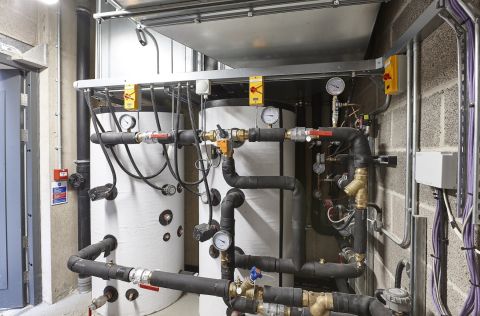Buying Guides
Our experts have put together the top things to consider for each of our product ranges. Helping you choose the best product for you and your family.
Portable Heating
Dehumidifiers
Air Purifiers
Cooling fans
Sustainability
Sustainability plays a key role in the future of Dimplex. We believe it's our moral responsibility to do what we can for future generations.

What is EN 15316?
EN 15316 offers guidelines that set out a common calculation method to estimate the energy use and energy performance of heating systems in buildings. The values are calculated for the whole installation and help to analyse the impact on energy performance. The values also help to establish energy performance indicators such as the Seasonal Performance Factor (SPF).

What is EN 14825?
EN 14825 sets out the temperatures, part-load conditions, and calculation methods for determining the Seasonal Coefficient of Performance (SCOP) and Seasonal Energy Efficiency Ratio (SEER). It applies to the operation of air-conditioning units, process chillers, and particular types of hybrid heat pumps. The values used to define the SCOP can be calculated or measured. If measured values are applied, the standard covers the applicable test methods.

What is EN 14511?
EN 14511 sets out standardised performance and rating terms for air-conditioning units, heat pumps and liquid chilling packages that supply space heating or cooling. EN 14511 is used for a determination of the Coefficient of Performance (COP) that gauges the performance of a heat pump.

What is diversity in HVAC systems?
What is diversity in HVAC systems, and how does it affect HVAC system design and specification for residential developments?
Diversity in HVAC systems within medium to large scale developments acknowledges that it is unlikely the maximum demand of all individual users of the system will arise concurrently. The total heat demand in a building is likely to be lower than the maximum or peak demand at various points in the heat network.

What is COP and EER?
The Coefficient of Performance (COP) and Energy Efficiency Ratio (EER) are measures of a heat pump or heating and cooling solution’s efficiency. They indicate a ratio of useful heating or cooling produced by the unit against the energy it consumes. For example, the COP of a heat pump that can provide 3kW of heat against the input of 1kW of electricity is 3. The EER that generates a cooling effect of 12BTU against the input of 1kW of electricity is 12.

What Building Regulations are changing during 2020?
2020 has been dubbed the year of change for the built environment, with Government keen on updating compliance targets for new and existing dwellings to enforce change in industries HVAC strategies.

What are the different types of heat pumps and where would you use them?
There are three types of heat pumps available for the built environment, classified by where they source their primary energy: air, ground or water. Each has its benefits depending on the application and specific design conditions.

Virtual reality and robotics: the future of building and design?
40% of architects and designers say technology will have biggest impact on industry in next 18 months

UK housing: Fit for the future?
On the 21st February 2019, the Committee on Climate Change(CCC) released their report on whether UK homes are fit for the future in regards to the challenges of climate change.

Boris Johnson’s Ten Point Plan: Clean and green, but is it enough to support the decarbonisation of heat?
Boris Johnson has launched his Ten Point Plan for a green industrial revolution. Ahead of COP26, this aims to show how committed Government is in making the UK a world leader in sustainability. But will this plan finally offer the infrastructure needed for the decarbonisation of heat?

How do we maximise the potential of heat pump technology to help us achieve net-carbon objectives?
The roadmap to achieve the UK’s 2050 net-zero carbon target is still relatively unclear. This creates uncertainty about the implementation of low carbon solutions in the industry. The lack of direction in turn affects the ability to plan for future developments. Difficult specification choices, doubts over futureproofing strategies, and lack of preparedness for regulatory changes, are just some of the factors affecting heat pump specification in new developments and existing buildings in both residential and commercial sectors.

Which technologies are the most viable to deliver the decarbonisation of heating?
To deliver the decarbonisation of heating, we should deploy a wide range of technologies that can help to eliminate the use of high carbon fossil fuels. Electric solutions, especially those that utilise renewable energy, offer a viable route to ensuring our homes are heated in a low carbon way. To successfully transfer to electrical infrastructures and make the necessary adjustments that bring us closer to achieving the UK’s 2050 net zero target, the industry will need a clear plan with achievable interim targets.











